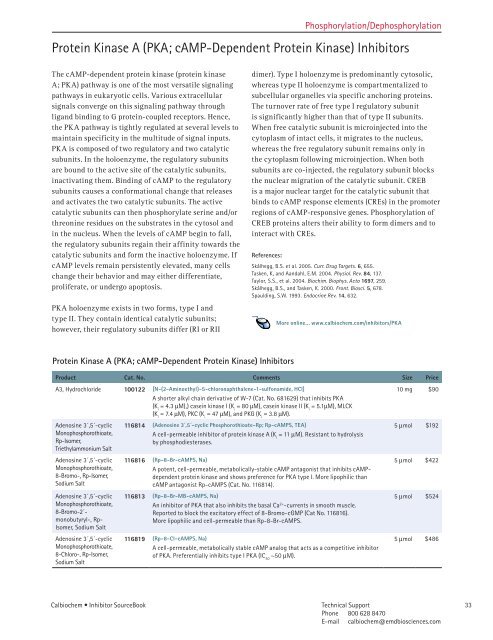Inhibitor SourceBook™ Second Edition
Inhibitor SourceBook™ Second Edition
Inhibitor SourceBook™ Second Edition
You also want an ePaper? Increase the reach of your titles
YUMPU automatically turns print PDFs into web optimized ePapers that Google loves.
Calbiochem • <strong>Inhibitor</strong> SourceBook<br />
Phosphorylation/Dephosphorylation<br />
Protein Kinase A (PKA; cAMP-Dependent Protein Kinase) <strong>Inhibitor</strong>s<br />
The cAMP-dependent protein kinase (protein kinase<br />
A; PKA) pathway is one of the most versatile signaling<br />
pathways in eukaryotic cells. Various extracellular<br />
signals converge on this signaling pathway through<br />
ligand binding to G protein-coupled receptors. Hence,<br />
the PKA pathway is tightly regulated at several levels to<br />
maintain specificity in the multitude of signal inputs.<br />
PKA is composed of two regulatory and two catalytic<br />
subunits. In the holoenzyme, the regulatory subunits<br />
are bound to the active site of the catalytic subunits,<br />
inactivating them. Binding of cAMP to the regulatory<br />
subunits causes a conformational change that releases<br />
and activates the two catalytic subunits. The active<br />
catalytic subunits can then phosphorylate serine and/or<br />
threonine residues on the substrates in the cytosol and<br />
in the nucleus. When the levels of cAMP begin to fall,<br />
the regulatory subunits regain their affinity towards the<br />
catalytic subunits and form the inactive holoenzyme. If<br />
cAMP levels remain persistently elevated, many cells<br />
change their behavior and may either differentiate,<br />
proliferate, or undergo apoptosis.<br />
PKA holoenzyme exists in two forms, type I and<br />
type II. They contain identical catalytic subunits;<br />
however, their regulatory subunits differ (RI or RII<br />
dimer). Type I holoenzyme is predominantly cytosolic,<br />
whereas type II holoenzyme is compartmentalized to<br />
subcellular organelles via specific anchoring proteins.<br />
The turnover rate of free type I regulatory subunit<br />
is significantly higher than that of type II subunits.<br />
When free catalytic subunit is microinjected into the<br />
cytoplasm of intact cells, it migrates to the nucleus,<br />
whereas the free regulatory subunit remains only in<br />
the cytoplasm following microinjection. When both<br />
subunits are co-injected, the regulatory subunit blocks<br />
the nuclear migration of the catalytic subunit. CREB<br />
is a major nuclear target for the catalytic subunit that<br />
binds to cAMP response elements (CREs) in the promoter<br />
regions of cAMP-responsive genes. Phosphorylation of<br />
CREB proteins alters their ability to form dimers and to<br />
interact with CREs.<br />
References:<br />
Protein Kinase A (PKA; cAMP-Dependent Protein Kinase) <strong>Inhibitor</strong>s<br />
Skålhegg, B.S. et al. 2005. Curr. Drug Targets. 6, 655.<br />
Tasken, K, and Aandahl, E.M. 2004. Physiol. Rev. 84, 37.<br />
Taylor, S.S., et al. 2004. Biochim. Biophys. Acta 1697, 259.<br />
Skålhegg, B.S., and Tasken, K. 2000. Front. Biosci. 5, 678.<br />
Spaulding, S.W. 993. Endocrine Rev. 14, 632.<br />
Product Cat. No. Comments Size Price<br />
A3, Hydrochloride 100122 [N-(2-Aminoethyl)-5-chloronaphthalene-1-sulfonamide, HCl]<br />
A shorter alkyl chain derivative of W-7 (Cat. No. 68 629) that inhibits PKA<br />
(K i = 4.3 mM),) casein kinase I (K i = 80 mM), casein kinase II (K i = 5. mM), MLCK<br />
(K i = 7.4 mM), PKC (K i = 47 mM), and PKG (K i = 3.8 mM).<br />
Adenosine 3´,5´-cyclic<br />
Monophosphorothioate,<br />
Rp-Isomer,<br />
Triethylammonium Salt<br />
Adenosine 3´,5´-cyclic<br />
Monophosphorothioate,<br />
8-Bromo-, Rp-Isomer,<br />
Sodium Salt<br />
Adenosine 3´,5´-cyclic<br />
Monophosphorothioate,<br />
8-Bromo-2´monobutyryl-,<br />
Rp-<br />
Isomer, Sodium Salt<br />
Adenosine 3´,5´-cyclic<br />
Monophosphorothioate,<br />
8-Chloro-, Rp-Isomer,<br />
Sodium Salt<br />
More online... www.calbiochem.com/inhibitors/PKA<br />
116814 (Adenosine 3´,5´-cyclic Phosphorothioate-Rp; Rp-cAMPS, TEA)<br />
A cell-permeable inhibitor of protein kinase A (K i = mM). Resistant to hydrolysis<br />
by phosphodiesterases.<br />
116816 (Rp-8-Br-cAMPS, Na)<br />
A potent, cell-permeable, metabolically-stable cAMP antagonist that inhibits cAMPdependent<br />
protein kinase and shows preference for PKA type I. More lipophilic than<br />
cAMP antagonist Rp-cAMPS (Cat. No. 68 4).<br />
116813 (Rp-8-Br-MB-cAMPS, Na)<br />
An inhibitor of PKA that also inhibits the basal Ca 2+ -currents in smooth muscle.<br />
Reported to block the excitatory effect of 8-Bromo-cGMP (Cat No. 68 6).<br />
More lipophilic and cell-permeable than Rp-8-Br-cAMPS.<br />
116819 (Rp-8-Cl-cAMPS, Na)<br />
A cell-permeable, metabolically stable cAMP analog that acts as a competitive inhibitor<br />
of PKA. Preferentially inhibits type I PKA (IC 50 ~50 mM).<br />
0 mg $90<br />
5 mmol $ 92<br />
5 mmol $422<br />
5 mmol $524<br />
5 mmol $486<br />
Technical Support<br />
Phone 800 628 8470<br />
E-mail calbiochem@emdbiosciences.com<br />
33



